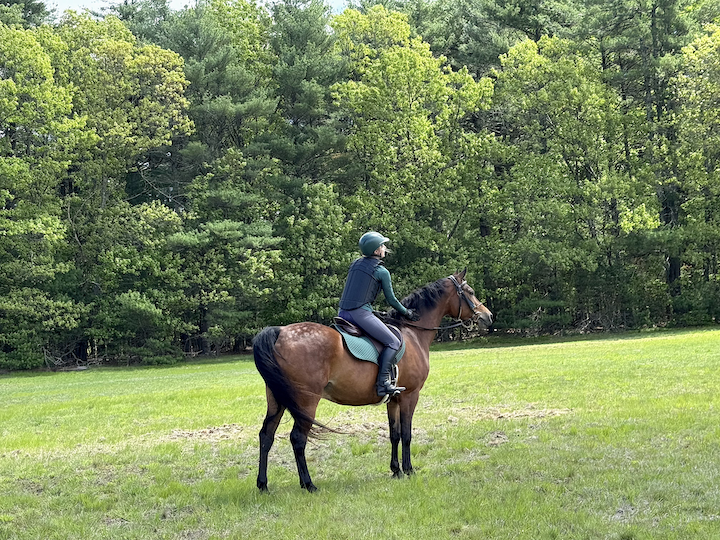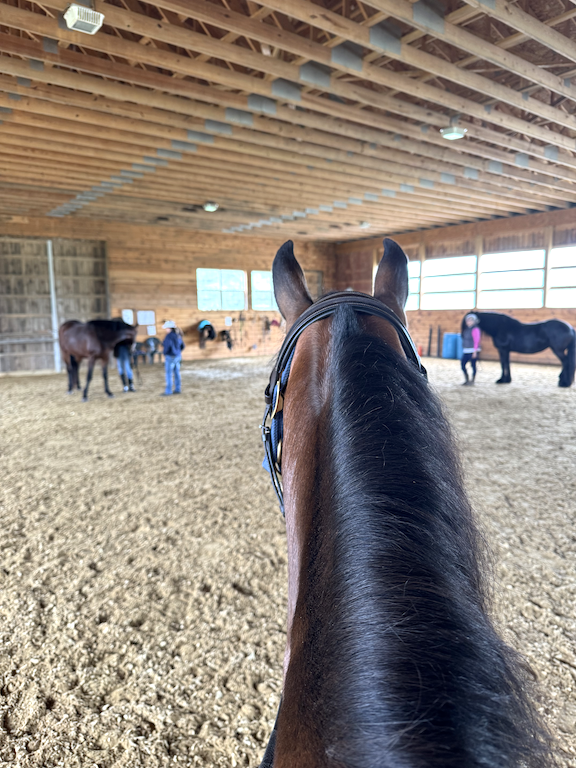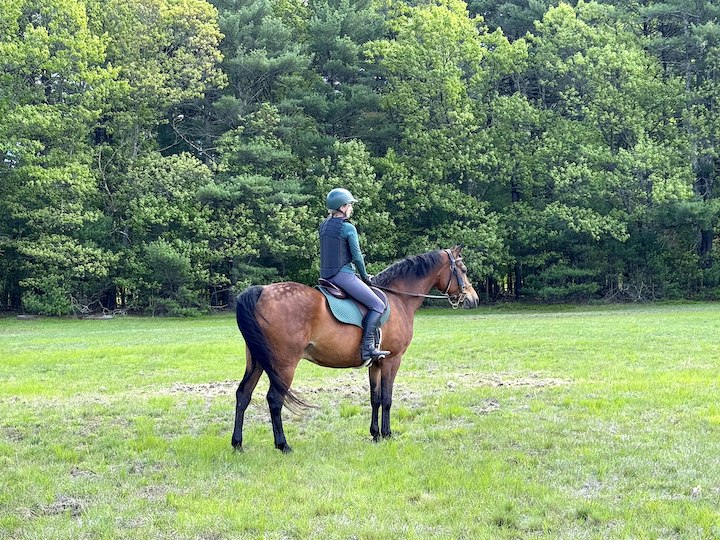Ready Or Not...

My plan for Levi's first driving show was to compete in the Pleasure class at the Myopia Carriage Classic which was held today. As I write this, the drivers are likely navigating their cones courses in a heavy downpour, which is one reason why I am glad we decided not to go. Levi hates rain, and working in it is always a huge distraction for us, so it is for the best that I didn't drive him at this event. We will need to work in less than favorable conditions if we ever want to earn the coveted title of 'boiled owl'. This particular show is quite intimidating as well, as it features some of the most accomplished and respected drivers in New England competing with their antique carriages and professionally-trained driving horses and ponies; these are intense competitors who would give us more than a little side-eye if we show up in our silly metal Frey Sprint cart, in a synthetic-and-leather Franken-harness, equipped with three trots that are still indistinguishable from each other, and proceed to ruin everyone's day with our mediocrity. I want Levi's first driving show to be a good experience for the both of us, but there aren't many options locally outside of this club. I have a few ideas, however, and we will keep working at preparing to give our best. Don't lose faith in us - you'll see.
I have also had to travel more frequently for work and personal reasons, further limiting our time to prepare for driving competitions. This week, I traveled to see my family (whom Levi has never met) for a rare visit; I received some really devastating news that means I will need to travel back and forth more often, meaning that our show schedule will be impacted. When I saw Levi again on Friday, I told him what was up since I always tell him anything important; he listens intently of course, and while he doesn't understand my words he seems to know the intention and emotions behind them. I created a little obstacle course in the outdoor arena and put him right to work under saddle, with a brief but intense workout, after matter-of-factly spilling the beans. What I am feeling, regardless of whether it is justified, should not affect any situation with the horse. We have work to be done, and we will do it regardless of my emotions. As trainers, I think it is crucial for us to be emotionally stoic and consistent, which includes keeping all that bad stuff from our human lives far away from the horse, at all times. My generous equine partner already carries my body safely - he should not have to carry my emotional burden as well. I am obligated to give him the best of my presence and focus, and he does not owe me anything.

Levi's first off-property outing in mixed riding and driving company took place last month, at an event with our local club. We trailered about 10 minutes to the Bradley Palmer State Park, which I've never been to before, and learned we were a bit late as the procession of carriages and equines of all shapes and sizes, accompanied by walkers and riders, rolled past as we were unloading. Levi knew immediately what was up and despite the new surroundings, was confident and determined to catch up! Not wanting to frustrate my eager mount, I launched into the saddle and we marched right down the trail... promptly missing an important turn. Joe kept pace alongside with a map to help navigate, but his navigation skills are a little off when he is nervous (which he was, walking next to an excited and eager horse on tip-toes blowing at everything) and after awhile we just shrugged and decided to explore instead of trying to locate our group. The trails are beautiful, filled with riders, hikers, dog walkers, and of course, the ever-dreaded bicyclists. Now, encountering cyclists was oddly one of the few situations I hadn't prepared Levi for, and not only seeing them at a distance but standing quietly as groups of them actually raced toward and past him on the trail, was novel. When confronted with cyclists for the first time, horses often react to them as terrifying half-human machine monsters, but fortunately as he has seen enough stuff with wheels this did not provoke him. I prepared myself for any reaction, but he just snorted and went full giraffe, head in the skies, body so tense that you aren't sure if he'll blow up into the stratosphere or just take off if you put a leg on. We stood, with me just sitting there not doing anything, and after a while, he realized the wheel-running 'herd' was not to be feared but only more nonsense from the people. He snorted, shook it off, and lowered his head. We took off down the trail to look at the next interesting thing without any further comment from Levi.
During our 4.5 mile ride, we saw and navigated many other new-to-Levi scenarios from big hills gated by narrow culverts, to forest groves filtering into wide open fields, and he did wonderfully well. On the way back, we caught a glimpse of our friends in their carriage with their over-achiever competition horse putting miles between them and anything with wheels. They told us we were going the wrong way but that it didn't matter as the carriages were having difficulty navigating some new construction on the trails and were turning back. We rode back to the parking lot with a couple of new members driving a Canadian horse in their carriage, and a been-there-done-that rider on his graceful old Warmblood who knew the park by hand and was a little amused at how we'd managed to get lost despite having a well-marked trail map. There were a few nice rolling hills that I let Levi trot up, and was quite happy that he chose to ignite the afterburners and break into a few strides of canter; what did I say about letting him cook? It might be a stupid (or stupider than schooling in a ring like a normal person) way to learn that upward canter transition... but if it's stupid and it works...

While our trail ride was completed with an A++ for Levi, nothing great is guaranteed, as when we tried to load up and go home, he dug his proverbial and literal heels in and refused to get back on the trailer. Joe and I did everything we could think of but he can be stubborn. As is well-known to Levi, my toxic trait is that I am quietly relentless, meeting his stubbornness on another level. It was a matter of wills. After 45 minutes (all in front of the driving club members, I might add, who were having a really nice picnic I'd wanted to join, and who were likely taking bets as to whether I'd be riding the horse back to his farm that night), we finally pushed him onto the rig in a final burst of momentum - Joe fastened the doors, we hopped in the truck, and managed to make it home just before a cloudburst. Levi looked a bit sheepish (and relieved) unloading when he realized he was back at home for his efforts, and all that protest was for nothing.
Later, a driver friend texted asking if everything turned out okay and if they should have offered to help. It's always difficult to watch people struggling to get horses to load and not know if you should try to step in, or not. It sometimes makes things worse. I think every single person watching the spectacle had gone through that same tribulation at some point, and I felt no embarrassment nor self-consciousness about it because I knew that any good horsemen had been there. The same horse calmly hopping in and out of his trailer at our recent show had decided to refuse on that particular day, and it was what it was. The unspoken sentiment among the group seemed to be that we could handle it and that, as my friend said, "if you can't get him on, there's no way that I could!" When do you step in and offer help when someone is having some trouble with a horse? Every situation is different, but I think compassion and knowledge coupled with a matter-of-fact attitude go much further than assertiveness, trying to take over the situation, standing around 'in support' while actually escalating, old-fashioned emotional reactivity, blaming, judgement, or calling upon the old gods and the new or smudging incense around. If we truly needed help, I am not too proud to ask for it, and we were fortunately in good company had we done so.
Conditioning work. Levi's life right now is trot transitions, transitions, transitions..
In the cart, we are doing well under Sam's guidance. She's fairly soft-spoken and usually suggests rather than tells, but when working with us in the cart she is very assertive and fast to correct any mistakes, reflecting her ability to give what is needed as a driving instructor. I really appreciate this, as the arenas have no mirrors to quickly check my position in real time and make adjustments. I always have to review our footage after the fact and try to remember what to do differently the next time (usually a lot!), which is less efficient. I think Levi's physical development under saddle is also improving his strength and stamina for driving. We just weren't ready for the carriage show today, unfortunately; looking at the video above carefully, what do you think? I guess we could have done it, but I don't like to take that energy of uncertainty into an important show. I also don't want to be the reason anyone else's performance is ruined in case my bet was wrong and everything goes sideways! Never want to be that guy.
I have a couple of little clips showing our process for hitching and unhitching without a header. These are interesting because, in the first clip where I hitch up to the cart, we dealt with two problems that had not been an issue before: while securing the shafts there was sudden pandemonium outside, in which a bunch of horses got loose on a merry chase, as well as a minor equipment malfunction. My process for hitching and unhitching is standard and the same every time: my lead line is clipped to the bit with the reins secured, and the lead line resting on the ground in front of the horse (or held if I need it for safety); cart and horse are aligned; I lift the shafts and slide the left shaft into the tug, and then secure the right tug (a quick-release style); tighten/secure the overgirth; quickly attach both traces to the singletree; fasten the holdback straps through the footman's loop, keeping the trace, in a figure eight wrap and secure the ends in the buckle; do a quick once-over to ensure everything is buckled, fastened, and secured; detach the lead line and bring it with me into the carriage; jump into the cart and secure my lines underneath me; take my whip in my right hand and adjust my reins; pause for a second to check in with the horse and briefly scan the environment; give my cue to walk on. Unhitching is almost identical, just reversed.
Hitching Levi to cart without a header. I taught him to ground tie for both driving and riding. He can be safely hitched like this all over the farm, but here I am working in our indoor which is actually much safer than hitching out in the open. During this hitch, my right quick-release tug clasp would just not close for some reason and I struggled with it for several seconds while Levi stood there like a saint! While I sorted that out, we learned a rodeo was going on outside, putting him on alert. While Levi usually doesn't move much when being hitched, he took a step forward and I stopped him immediately. Sometimes he will move a hind leg to shift his hindquarters forward to allow me to fasten the breeching more comfortably. However, stepping forward with the front leg is an absolute no-no under any circumstances.
With a header, my personal preference is that person stands out of view of the horse, behind the blinker and about a foot or so from the horse's head, and keeps talk or interacting with the horse at a minimum. I have experienced people introducing various distractions via treats, pats, affectionate greetings, or misplaced expressions of empathy "oh, poor little boy has to work - mummy is just so evil and mean!" which are all unproductive. It isn't that I don't want others to have a relationship with the pretty horsey, but rather to keep our monkey-minded green bean of a Levi focused on his upcoming task of driving the cart, and distinguish driving-mode from people-enjoying mode. People unfamiliar with driving see this moment of respectful quietude in these horses and can mistakenly believe that carriage horses are "shut down" or suffering when in reality, these are highly trained athletes that are using the time to save energy, go within, get calm within their minds and bodies, and prepare themselves for what they are asked to do next. I have observed this state of going within before competitions in every carriage driving horse at a show. This is an intelligent response and not a powerless one. They have been trained to stand like this, and it is for everyone's safety that they not be interfered with nor misunderstood. Please do not, ever, approach a driver and attempt to touch or pet their horse, with or without permission. People grabbing reins or bridles have been stunned to find themselves holding a horseless bridle, sometimes after being knocked to the ground by the horse's chest or carriage shaft. When we strap a horse to a carriage, he becomes a living projectile; do you really want yourself or anyone vulnerable such as a child near that situation? The driving horse cannot see what is immediately in front of and around him very well, and he is relying on the driver's skill to help him navigate. Please do not offer treats to working horses without a driver's permission, nor get angry with drivers who may be terse in their response to questions or even ignore you when we are operating the carriage or horse - we are not being haughty or rude bastards, I promise (at least not all of us). Our job is to keep ourselves and everyone else safe while driving. The most vulnerable state in which humans and horses can be hurt while driving is during hitching and unhitching, and when the driver is getting in and out of the carriage, and this is why we are so strict and systematic with these processes.
The unhitching sequence. This always goes very well because he knows he is done with his work and it's time to relax. However, I remain on guard and still require his full focus and participation. The sequence is the opposite of hitching; I dismount and secure my reins, clip my lead line to the bit, unfasten the holdback straps from the cart, release and secure the traces from the singletree, and then gently slide the shafts from the tugs and lift the cart (trying to avoid catching it on the breeching - too bad I am not taller for more leverage!) over the back and roll it safely away from the horse. I remove the reins from the bit also as I prefer to lead a horse with a lead rope and halter, without the reins attached, to and from the barn. A lightweight head collar goes over or under the bridle, with the lead rope on the ring of the halter. We stand for a moment before we walk off. Afterward, we can praise the horse and celebrate another fun, safe drive!
Lately, we have been working on improving bend and circling to the right, as Levi's left hind leg is weaker, while that right hind has been working overtime. He tends to counterbend when he's tired or I haven't set him up correctly on the right. I feel like I drive two horses sometimes, based on the direction he's traveling, but this can be improved with correct work and time. I measured out a 30 m circle with the cones and try to consistently drive something resembling a 30-40 m circle, although often we will drive a square instead. I'm pretty sure those squares he loves driving so much are not part of any dressage tests!
Working to the right in the cart. We drive a lot of figure 8's, serpentines, and arcs in both directions.
Uncertainty as a result of my family's situation will dictate what portion of summer I can devote to showing, but I will still prepare us for the shows we have planned. As always, and no matter what, I could not ask for a better partner than my Morgan.
Attentiveness to His Majesty's hydration is required. Every aspect of the process must pass careful inspection, and only pristine waters are acceptable!
Member discussion